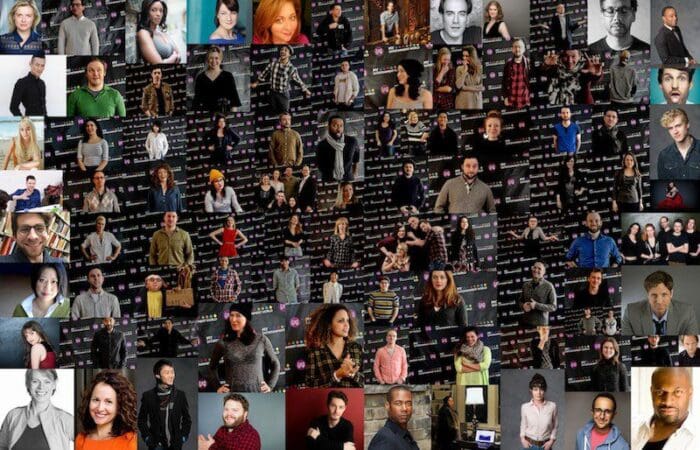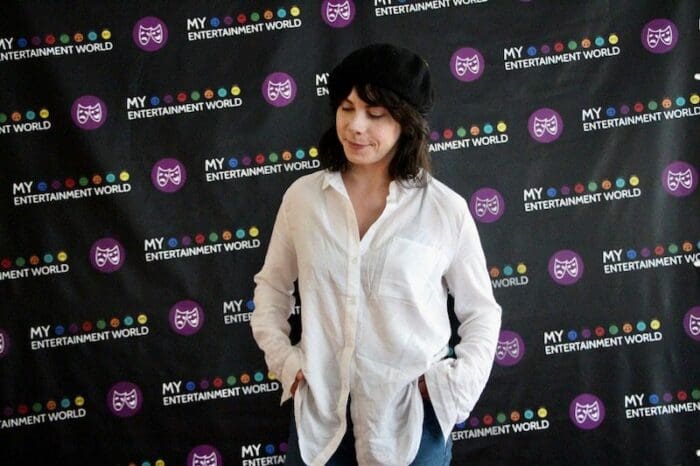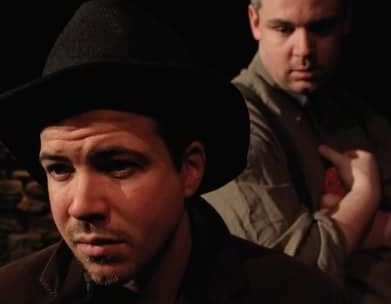 Before we announce the winners of the 2016 MyTheatre Awards, we’re proud to present our annual Nominee Interview Series.
Before we announce the winners of the 2016 MyTheatre Awards, we’re proud to present our annual Nominee Interview Series.
Lindsay Junkin won an Outstanding Set & Costume Design MyTheatre Award last year for her work on Mr. Burns: A Post-Electric Play. After designing for three different Outstanding Production-nominated shows in 2016, she’s nominated again in the same category, this time for her indie work with set designer Adam Belanger for their collaboration on Unit 102 Actor’s Company’s production of Of Mice and Men, a visually stunning, period-accurate tour de force.
 Catch us up on your life since we last talked to you for the 2015 Nominee Interview Series.
Catch us up on your life since we last talked to you for the 2015 Nominee Interview Series.
I don’t know how to describe it other than just going ahead and keep working. I got some really amazing opportunities at Soulpepper. I got to assist there, and do Chasse-Galerie there. Working in those kind of theatres is very new to me, so it’s just been an exciting year of growth, really. Just slowly making my way from indie into more professional theatre.
How do you get involved with Of Mice and Men?
I actually started my theatre work with Unit 102. I met the guys who ran the space and, at the time I was actually doing disability advocacy. But making things was always my hobby. And they needed people to do stuff, so I would just volunteer to do stuff, and so for 4 years I worked at Unit 102. Then I left the company for a while, and I went and did other things, and then Dave Lafontaine asked me if I wanted to come back and do the show. I really wanted to work with Dave again, so it was a no-brainer. It was like “yes, definitely, please.”
What’s he like as a director?
Dave really knows what he wants. And when he does a show, generally it’s a passion project for him, and it’s something that’s really meaningful for him, and he just has a vision for it. So, working with him as a director is so great because there are some things that he’ll always give you the leeway to do. He trusts the people that he brings into a room, but he also has his own pace, and he has his own opinions, and he drives the story forward, so it’s really this great collaboration between what I can bring to it, and what he can bring to it.
 How much research went into capturing the period of the costumes?
How much research went into capturing the period of the costumes?
Definitely a bunch. I tried to learn as much as I could about different kinds of movements around transient workers of the time, because there were so many different fields that people were trying to do. And then focus more and more in California. To see economic social climate- the way a man would wear a hat, and where he would wear the hat. You know, the little details that make so much sense, like jeans and manufactured clothing. We came up with all these questions that we realize aren’t well-known. What was the state of being able to find boots? Are they being cobbled for you individually, or is everything manufactured? So it was a really interesting learning process about what the state of industry was at the time. So a lot of research. I didn’t know a lot about the subject before.
What were some of the small character details that went into the costume work?
I wanted to make sure the clothes were authentic, that they were dirty in the right ways for what kind of work each guy was doing on the farm. That meant a lot to me, to try and get the authentic – what would be worn out, where would it be worn out? Why would they have this mud on their shoes? It became about getting the right grime for the right situation. And then also about playing with status. You have the father and the son, who are higher status than everyone else, but how did they show status in other ways? So some details became, like, who is more comfortable in dirtier clothes? Who wants to show more masculinity or more status by not wearing suspenders? It became just a really interesting investigation of how abused men show their status in a world where a lot of them feel quite disenfranchised, in a big way.
You’re nominated alongside Adam Belanger, who did the set design. Was there much collaboration between the two departments?
Definitely. We wanted to have an overall feel for our town and texture. So it was a lot of colour stuff that we were working out, and then just kind of sharing what we knew, and making sure that we felt like we were accurately representing the entire scope of that time.
What were some of the practical demands of the production that you had to deal with?
Well, there’s a lot of blood at the end of Act 1- not to mention a lot of the grime, to do it in a non-toxic way, we had to use a lot of methods like tea-staining and stuff like that- but then you have blood. One big practical hurdle was, how do you wash the blood out without washing the [dirt] effect that we’ve done to the costumes along with it? So that was something we had to kind of mitigate and figure out. [The effects] definitely faded over time. Every time you use blood onstage, for costumes specifically, it can take a toll. So, just trying to figure out the best way to do it, and how it will affect other things in the long term. So, blood.
Did you have any big ideas that were edited out for practical reasons like budget or time?
The older man who’s an amputee, I really wanted to go further with what we were gonna do with his hand. I designed this pair of overalls that would actually be a sling, that just kind of didn’t work out, and we didn’t have time to do it with everything else. So that was a shame; I really had wanted to do something a bit more detailed, less “this is the most practical solution”. I wanted to go further with it.
What was your favourite design element in Of Mice and Men?
I’m gonna talk about costumes in a way like a landscape for a second. There were certain moments where you’d see several characters together, and the way the palettes would work off each other, they’d become this actual visual that’s almost like a photograph. When I saw it onstage, they would just hit these moments like this beautiful, perfect photograph where I felt that the colours would balance properly, and everything was just gorgeous.
Did you have a favourite moment in the production?
My favourite moment was actually after the unfortunate death of Curly’s wife, where they’re starting the chase, and we transition from the barn to the landscape again. One of the most genius things of what Adam did was, that wall that comes up and down, because of all the straw that was getting kicked around in the show, I don’t think he ever intended this but, when they do the barn-raising action, the straw- just out of the force of the wall going up- it just kind of explodes in the light, and it’s one of the most beautiful things I’ve ever seen. I think that’s half of the emotion going into that scene, with just chaos, stuff in the air. There’s something actually tangible in the air ready to explode. Definitely my favourite.
You worked on three different shows that are nominated for Outstanding Production this year. Tell us about your experiences on Chasse-Galerie and the challenge of transferring an indie show to a bigger stage like Soulpepper.
Chasse-Galerie was interesting, especially the fact that it was a remount. Coming in and not having participated in the first run was kind of interesting because, obviously, it had this foundation already to it. But Tyrone [Savage, adapter and director] was really great about his openness to me, and what I wanted to do with it. It was kind of wonderful to just do a simple set in a big theatre but still make it our own, because the idea was always to make it a site-specific kind of feel; immersive, but in the Young Centre. So it was really great to get to work on that. Especially for me, being new in set designs, I think my saving grace was the fact that I’d worked in that theatre just a few months before on The 39 Steps, so it felt homey. I knew the crew, and it really helped transition from how I would work on a set in indie life to doing it professionally.
How’d you get involved with Soulpepper?
Ken MacKenzie. Ken and I met on Mr. Burns, and we got along really well, and he kinda took me under his wing. He’s been really great, giving me opportunities and supporting my career. I’ve assisted him on a few shows now actually, and it’s just been a really supportive relationship.
You also did the costumes for Outside the March’s TomorrowLove. How did you approach that project?
Mitch [Cushman, the director] and I started talking about the show a long time ago, and when we talked about it, we wanted the future to be that kind of sci-fi where it’s not far off. It’s a world that feels familiar but there’s different details to it. Initially my first concept was I’d wanted to approach a Toronto-based clothing designer and have all one line, all the show done in that, and then we would brand it in the same way that everything’s branded in the show- that kind of commercialism that comes with technology. But unfortunately it just didn’t work out, so I ended up just amassing the costumes. But what I really wanted from it, and what we really want to do with it, was make something that was individualistic but was still this world, that was different but kind of like a Gap ad that came to life. So it was just about making this Apple-meets-Gap meets- all those big brands and how they brand themselves. We wanted to brand the show in a certain kind of style and costume.
What are you saying about the future of fashion in terms of things like waistlines and the shapes and colours that are being used?
Well, the colours was definitely a scheme, it’s probably a little Stepford. The colours are something that, for me, what was important was to have this binary-ism to the characters because of what they’re going to do. I wanted to see these different colour combinations all the time, so we had those four main colours and each person would wear one of those four colours.
When I think that about the future, I think about disposable clothing and the way that we spend our money. There is something deceiving about the simplicity of that- this is just easy, and it’s friendly-looking; I wanted to reflect that homogeny. So the costumes are in some ways very normal-looking things. But, line-wise, I wanted to throw a few more future things in there, like wide-legged pants and super turtlenecks, so I did that.
With the actors all playing different parts without changing their costume, how did you customize that aesthetic to each performer and have it work for each individual part they might be playing on that night?
Truly, one of the great things about the costumes is that, as much as they have individuality to them, they’re a blank slate. So in another way, that simplicity was just another way for them to transform through themselves. The costume became kind of a background aspect to it, kind of interchangeable. A lot of the costume work just became what is interesting visually in some moments, but you wouldn’t take a lot of notice of it. That way the actors could take full empowerment to be able to transform in between scenes without us having to worry about “should they roll up their sleeves, should they do this?” It’s not about the costumes because, in this world, everyone is wearing these clothes. It’s more about the actor.
